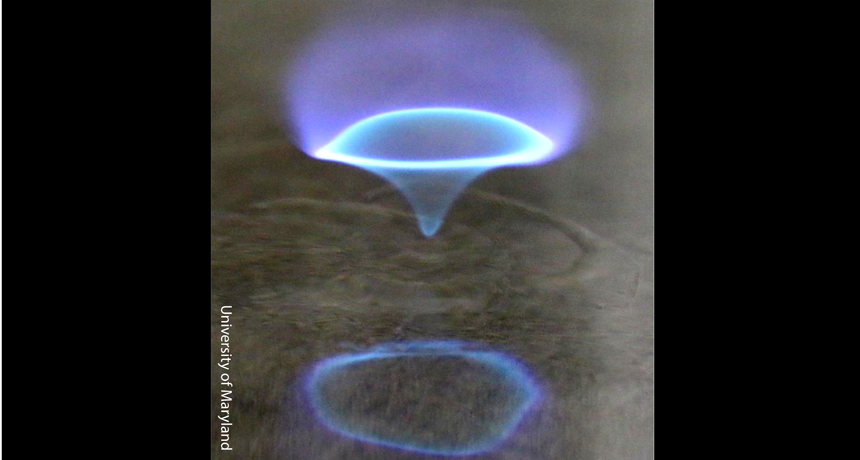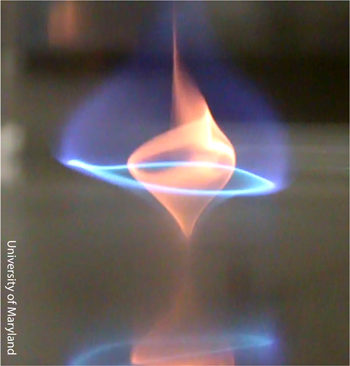Lab creates new, unexpected type of ‘firenadoes’
These tiny blue cyclones of flame could become the next big thing in clean combustion

Researchers studying fire in the lab unexpectedly discovered a new type of fiery vortex. This swirling “blue whirl,” which burns exceptionally hot, creates very little soot.
University of Maryland
By Sid Perkins
Researchers studying large swirls of fire in the lab have unexpectedly stumbled upon something new. It’s a small, blue, fiery vortex. This tiny tornado of flame burns incredibly hot and produces very little soot. If these fires can be created reliably — and controlled — they might offer a range of benefits. For instance, they might clean up oil spills in the water. And someday, they might even play a big part in clean combustion of fuel in devices such as furnaces or hot water heaters.
Fires can be devastating. They also tend to be largely unpredictable. Those are just two reasons why many scientists study them. If researchers can figure out how fires behave, they might better predict where and how quickly blazes might spread. That could save lives as well as prevent property damage.
One of the more fascinating aspects to wildfires is the fiery whirlwinds that suddenly spring to life within what seems to be a normal wall of flame. These fire whirls — also known as “firenadoes” — can grow dozens of meters (yards) high, notes Elaine Oran. She is an aerospace scientist at the University of Maryland in College Park. Fire whirls are especially dangerous, she notes: They can lift small bits of burning material high into the air. From there, the material can fly off to distant sites, triggering new fires. So, these fiery whirls are a topic of intense study in Oran’s lab.
She and her teammates create the cyclones of fire in several ways. In one setup, they pump a liquid fuel onto the surface of a small pool of water. That fuel, called heptane (HEP-tayn), is a component of gasoline. When lit, this fuel evaporates, mixing with air.
One part of the team’s equipment guides air into an open-topped cylinder that surrounds the floating blob of fuel. This cylinder acts like a chimney. Incoming air creates a slowly swirling vortex inside the cylinder. As the burning vapors whirl and rise, they draw more air into the cylinder. This intensifies the swirling. Soon, instead of a roaring fire, there’s a whirling firenado. In the lab, these fiery cyclones can be around 1 meter (about 3 feet) tall. The researchers keep the firenado that size or smaller by controlling the fuel supply, Oran notes. If it grew much larger, they might quickly lose control over it.
Both the original blaze and the firenado that follows are loud. That’s a sign the airflow inside the fire is turbulent, or chaotic, says Oran. But during one experiment the team’s firenado shrank and evolved into a blue whirl of flame just a few centimeters (a couple of inches) tall. “We’ve never seen that before,” she notes. Certainly, she adds, “We didn’t expect it.”
That tiny blue whirl was very quiet. And that was one clue that the air flowing inside the flame was smooth, not turbulent. Its blue hue also signaled that this flame was much hotter than normal, maybe a couple of thousand degrees Celsius (a few thousand degrees Fahrenheit) rather than a few hundred. It also means combustion inside the whirl was not creating soot — the black, oily carbon that typically gives a flame a yellow hue.

Besides burning hot and quiet, the little blue whirl was stable. “We found we could keep it going as long as we fed it fuel,” Oran says. “It’s a hungry little beast.” And when the fuel disappears, the flaming whirl dies out quietly.
After the flame was gone, the team tried to relight the water’s surface, where the fuel had been. But nothing happened. This signaled all of the fuel was gone. Any remnants had burned away, evaporated or sunk.
Floating oil spills cause huge problems, notes William Roberts. He’s an aerospace engineer who was not part of the research team. Roberts works at King Abdullah University of Science and Technology in Thuwal, Saudi Arabia. The oil from a spill can wash ashore to poison beaches and coat birds, he notes. Lighter gases or liquids in the oil can evaporate, polluting the air. The gunkier parts left behind will sink, fouling the ocean floor.
Plus, it’s really tough to recover spilled oil. Even where it can be collected, it usually can’t be used, Roberts notes. If people could find a way to create and control blue whirls, “it might be a way to burn spilled oil cleanly,” he says.
The team’s discovery shows the importance of doing lab studies of complicated phenomena such as fire, Roberts adds. “It’s that sort of looking that causes you to find things” like blue whirls, he observes. “This is something really cool. Now let’s figure out why it works and how we might be able to harness it.”
José Torero is an expert on fire safety at the University of Queensland in St. Lucia, Australia. Fires of all types, whether artificial or natural, are very complicated, he says. Within flames, all sorts of complex chemical reactions take place. There also are many ways for fires and streams of air to interact and influence each other. “There are fundamental physical processes going on in and around fires that we don’t understand,” he points out. “If we understood them better, we could better forecast how fires would behave.”
Until that day comes, people need to keep studying fires in the lab — and maybe stumbling across new and unexpected things like blue whirls.







